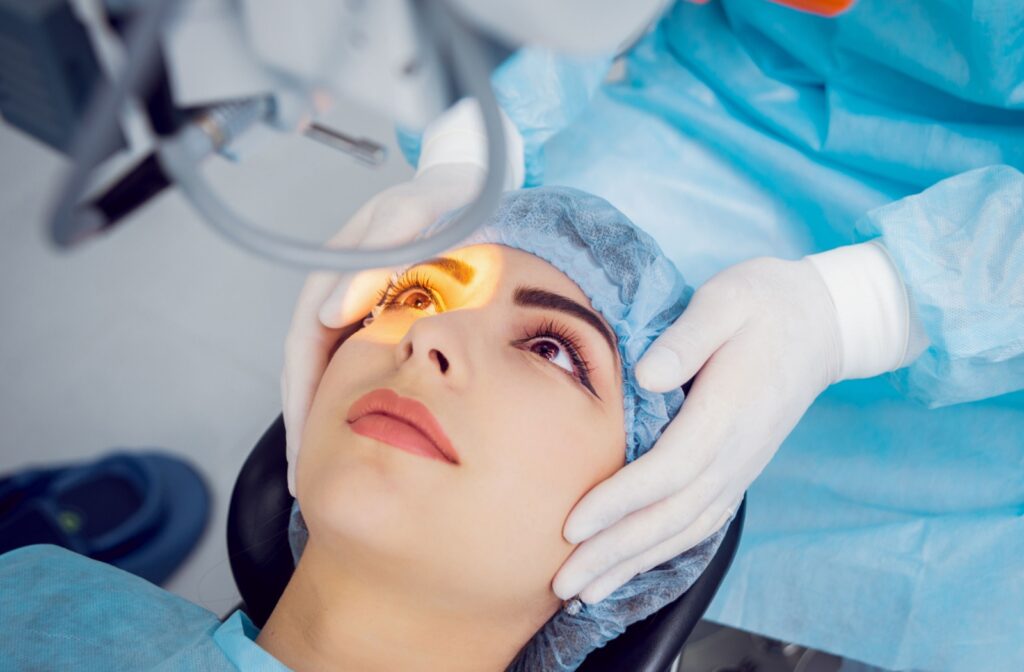The prospect of casting off your glasses or contact lenses is a tempting one, opening a world of unobstructed, clear vision. Laser eye surgery, also known as refractive surgery, is a popular means to achieve this freedom.
However, laser eye surgery isn’t a miracle treatment for everyone with vision problems. Laser eye surgery may not be right for you if:
- You’re younger than 18
- Your vision is unstable
- You have certain corneal problems such as keratoconus, keratitis, or thin corneas
- You have irregular astigmatism or an extreme prescription
- You have moderate or severe dry eyes
- You have certain medical conditions
- You’re pregnant or breastfeeding
What Is Laser Eye Surgery?
Before we venture into the who’s, why’s, and why-not’s, let’s understand the nuts and bolts of the laser eye surgery process. In Canada, 3 primary procedures cater to different eye structures and patient requirements, and an optometrist can help you choose the one that suits your needs.
PRK (Photorefractive Keratectomy)
PRK was the first laser eye surgery procedure to be used for vision correction. It’s an alternative to LASIK performed on the eye’s surface, directly on the cornea. The surgeon removes the cornea’s outer layer before a precise, computer-guided laser reshapes the cornea to better focus light on the back of the eye.
Because it involves the least amount of tissue removal compared to other surgical options, doctors often recommend this procedure for people with thin corneas or who are at risk for certain corneal conditions. It takes longer to heal than other types of laser eye surgeries.
LASIK (Laser-Assisted In Situ Keratomileusis)
LASIK is the most common form of laser eye surgery and is slightly more complicated than PRK. Instead of removing the cornea’s outer layer, your surgeon creates a thin, hinged flap. After this, a laser gets rid of tiny amounts of eye tissue to reshape the underlying cornea.
Your surgeon then repositions the flap to heal naturally, reducing the recovery time.
LASEK (Laser-Assisted Sub-Epithelial Keratectomy)
LASEK is a hybrid of PRK and LASIK, combining aspects of both processes. During the procedure, the surgeon uses a solution to soften the epithelial layer of your eye and lift it back before a laser is used to reshape the cornea. The epithelial layer is then repositioned post-surgery. LASEK is ideal for minor vision problems.
Each of these procedures is tailored to specific patient needs, and their suitability is determined by your medical history, corneal thickness, and other ocular factors.
Who Is a Candidate for Laser Eye Surgery?
While laser eye surgery is a remarkable advancement in modern medicine, it’s not without limitations. Certain individuals should exercise caution before jumping into the surgical chair.
Here are some factors your optometrist may look for.
Your Age
You will have to be at least 18 years of age to have laser eye surgery, though some doctors may prefer you be even older. Since our eyes can keep growing until we’re 21, it’s important to wait before attempting laser eye surgery.
A Stable Prescription
Your vision needs to maintain a stable prescription for at least a year before considering surgery. Fluctuating vision may be a sign of other systemic health issues or, at the very least, make refractive surgery ineffective as your vision continues to change.
Corneal Thickness
Problems with the cornea are significant factors that could disqualify you from surgery. Since surgery requires removing a certain amount of tissue, your eyes need to possess a healthy amount.
While PRK can be an option for some people with thinner corneas, there is a limit to what it can achieve. Others who may not qualify for laser eye surgery include those with keratoconus, keratitis, corneal edema, or other medical conditions that affect the eye.
Irregular Astigmatism & High Prescriptions
We’ve advanced much when it comes to eye care, which means many people with astigmatism can still benefit from refractive surgery. But for some types of astigmatism, the laser’s precision may be unable to provide the predictability needed to confidently fix your vision.
The same can be said about high amounts of myopia or hyperopia. While you may technically be suitable for laser eye surgery, the amount of vision improvement could be minimal.
Eye Health
A major part of every consultation is the eye exam. This is where we build a profile of your vision and health, looking for anything that may affect the surgery’s success. For example, laser eye surgery could exacerbate moderate to severe dry eye. It’s a good idea to try to get your symptoms under control before pursuing refractive surgery.
Additionally, the risks of laser eye surgery can increase if you have eye health conditions such as diabetes, glaucoma, or eyelid infections. Other conditions, such as cataracts, simply can’t be fixed with laser eye surgery.
Pregnant or Nursing
Doctors typically advise anyone pregnant or nursing against the procedure due to hormonal changes that could affect the eye’s prescription. These changes can be temporary, so the way your eyes focus could change again after surgery is complete.

The First Step Toward Laser Eye Surgery
Even if you fit the criteria, laser eye procedures demand thorough contemplation. It’s important to have realistic expectations about the level of correction and the risks inherent in any surgical procedure.
While many people are satisfied after their procedure and achieve the clear vision they always dreamed of, others could be disappointed if their eyes continue to change and still require glasses or contacts.
A laser eye surgery consultation at Willoughby Doctors of Optometry is the time to discuss all of your concerns, potential risks, the reality of benefits, and what to expect during and after the process.Ultimately, the decision to undergo refractive surgery is a personal one. If you’re curious about laser eye surgery, why not ask the professionals? Book your consultation and take the first step towards the potential of a glasses-free future.











